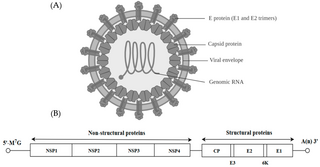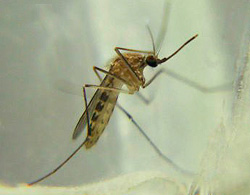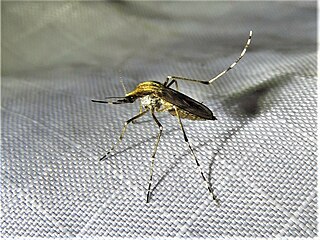
Aedes albopictus, from the mosquito (Culicidae) family, also known as the (Asian) tiger mosquito or forest mosquito, is a mosquito native to the tropical and subtropical areas of Southeast Asia. In the past few centuries, however, this species has spread to many countries through the transport of goods and international travel. It is characterized by the white bands on its legs and body.
La Crosse encephalitis is an encephalitis caused by an arbovirus which has a mosquito vector.
Eastern equine encephalitis (EEE), commonly called Triple E or sleeping sickness, is a disease caused by a zoonotic mosquito-vectored Togavirus that is present in North, Central, and South America, and the Caribbean. EEE was first recognized in Massachusetts, United States, in 1831, when 75 horses died mysteriously of viral encephalitis. Epizootics of EEE in horses have continued to occur regularly in the United States. It can also be identified in donkeys and zebras. Rarely, it can also infect humans. Due to the rarity of the disease, its occurrence can cause economic impact beyond the cost of horses and poultry. EEE is found today in the eastern part of the United States and is often associated with coastal plains. It can most commonly be found in East Coast and Gulf Coast states. In Florida, about one to two human cases are reported a year, although over 60 cases of equine encephalitis are reported. In years in which conditions are favorable for the disease, the number of equine cases is over 200. Diagnosing equine encephalitis is challenging because many of the symptoms are shared with other illnesses and patients can be asymptomatic. Confirmations may require a sample of cerebrospinal fluid or brain tissue, although CT scans and MRI scans are used to detect encephalitis. This could be an indication that the need to test for EEE is necessary. If a biopsy of the cerebrospinal fluid is taken, it is sent to a specialized laboratory for testing.

Alphavirus is a genus of RNA viruses, the sole genus in the Togaviridae family. Alphaviruses belong to group IV of the Baltimore classification of viruses, with a positive-sense, single-stranded RNA genome. There are 32 alphavirus species, which infect various vertebrates such as humans, rodents, fish, birds, and larger mammals such as horses, as well as invertebrates. Alphaviruses that can infect both vertebrates and arthropods are referred dual-host alphaviruses, while insect-specific alphaviruses such as Eilat virus and Yada yada virus are restricted to their competent arthropod vector. Transmission between species and their vertebrate hosts occurs mainly via mosquitoes, making the alphaviruses a member of the collection of arboviruses – or arthropod-borne viruses. Alphavirus particles are enveloped, have a 70 nm diameter, tend to be spherical, and have a 40 nm isometric nucleocapsid.

Culex or typical mosquitoes are a genus of mosquitoes, several species of which serve as vectors of one or more important diseases of birds, humans, and other animals. The diseases they vector include arbovirus infections such as West Nile virus, Japanese encephalitis, or St. Louis encephalitis, but also filariasis and avian malaria. They occur worldwide except for the extreme northern parts of the temperate zone, and are the most common form of mosquito encountered in some major U.S. cities, such as Los Angeles.

The Culicinae are the most extensive subfamily of mosquitoes (Culicidae) and have species in every continent except Antarctica, but are highly concentrated in tropical areas. Mosquitoes are best known as parasites to many vertebrate animals and vectors for disease. They are holometabolous insects, and most species lay their eggs in stagnant water, to benefit their aquatic larval stage.
Ochlerotatus cantator, the brown saltmarsh mosquito, is a species of mosquito from the genus Ochlerotatus. It was formerly known as Aedes cantator. Several Aedes species have been reclassified as Ochlerotatus, O. cantator being one of them.
Ochlerotatus is a genus of mosquito. Until 2000, it was ranked as a subgenus of Aedes, but after Reinert's work, the clade was upgraded to the level of a genus. This change has resulted in the renaming of many subgenus species, and many aedini-related taxa are undergoing taxonomic revisions. Some authors are still using traditional taxonomic names in their publications.

Aedes triseriatus is a member of the true fly order. It is called the eastern treehole mosquito due to its predilection towards breeding in stagnant water that is found in natural holding containers such as tree holes. It is native to the eastern United States and southern Canada and favors hardwood habitats. It has been found as far south as the Florida Keys, as far west as Idaho and Utah, and as far north as Quebec and Ontario. This species has not yet been found in Europe, but it has the potential to spread through international trade. In 2004, it was found in a shipment of tires travelling from Louisiana to France, but it was identified and targeted with insecticides that truncated its spread. It is a known vector of La Crosse encephalitis and canine heartworm disease. In the laboratory, it has been found to vector several other viruses including yellow fever, eastern encephalitis, Venezuelan encephalitis, and western encephalitis. Because of its potential for international spread and its proclivity for transmitting disease, monitoring the distribution of this species is essential.

Salt pannes and pools are water retaining depressions located within salt and brackish marshes. Pools tend to retain water during the summer months between high tides, whereas pannes generally do not. Salt pannes generally start when a mat of organic debris is deposited upon existing vegetation, killing it. This creates a slight depression in the surrounding vegetation which retains water for varying periods of time. Upon successive cycles of inundation and evaporation the panne develops an increased salinity greater than that of the larger body of water. This increased salinity dictates the type of flora and fauna able to grow within the panne. Salt pools are also secondary formations, though the exact mechanism(s) of formation are not well understood; some have predicted they will increase in size and abundance in the future due to rising sea levels.

Culex quinquefasciatus, commonly known as the southern house mosquito, is a medium-sized mosquito found in tropical and subtropical regions of the world. It is a vector of Wuchereria bancrofti, avian malaria, and arboviruses including St. Louis encephalitis virus, Western equine encephalitis virus, Zika virus and West Nile virus. It is taxonomically regarded as a member of the Culex pipiens species complex. Its genome was sequenced in 2010, and was shown to have 18,883 protein-coding genes.

Aedes canadensis, the woodland pool mosquito, is an aggressive, day biting mosquito that can be a vector of a number of diseases which is found mainly in eastern North America.

Coquillettidia perturbans is a species of mosquito that have been documented in every continent except Antarctica. This mosquito is a known as a vector of West Nile virus and Eastern equine encephalomyelitis. The geographic range of C. perturbans is increasing due to the growing extensity of the feeding area. They are known to exist throughout the United States, mainly with a southern distribution, and are mammalophilic.
Jamestown Canyon encephalitis is an infectious disease caused by the Jamestown Canyon virus, an orthobunyavirus of the California serogroup. It is mainly spread during the summer by different mosquito species in the United States and Canada.

Aedes mitchellae mosquitoes were originally collected in southern Georgia and Florida in 1905 by entomologist Harrison Gray Dyar, Jr. The species' range extends through the coastal plains from the southeastern United States, north to New York and west to New Mexico with the greatest abundance in the Atlantic and Gulf coastal plains.

Aedes japonicus, commonly known as the Asian bush mosquito or the Asian rock pool mosquito, was first described by Theobald in 1901 from Tokyo, Japan. They are competent arbovirus vectors known to transmit the West Nile virus as well as Japanese and St. Louis encephalitis. They are listed as an invasive species by the Global Invasive Species Database.

Opifex fuscus, known commonly as the saltpool mosquito or by its Māori name naeroa, is an endemic mosquito that is widespread along the coast of New Zealand.

Aedes taeniorhynchus, or the black salt marsh mosquito, is a mosquito in the family Culicidae. It is a carrier for encephalitic viruses including Venezuelan equine encephalitis and can transmit Dirofilaria immitis. It resides in the Americas and is known to bite mammals, reptiles, and birds. Like other mosquitoes, Ae. taeniorhynchus adults survive on a combination diet of blood and sugar, with females generally requiring a blood meal before laying eggs.

Aedes scapularis is a species of mosquito primarily found in neo-tropical regions of the Americas.

Aedes infirmatus, informally referred to as the infirm American pointy mosquito or silverback mosquito, is a species of mosquito that is found in woodland environments in parts of Central America, Mexico, and the southern United States, with a type locality in Baton Rouge, Louisiana. In the United States, they have been found as far west as Texas and as far north as New Jersey.















